Rado combines a nautically inspired bronze case with a lush, burgundy- colored dial and bezel insert in the most vibrantly colorful model to date in the Captain Cook collection, the Captain Cook Burgundy Bronze, which I had a chance to obtain for a review back in the winter. Scroll down for details.
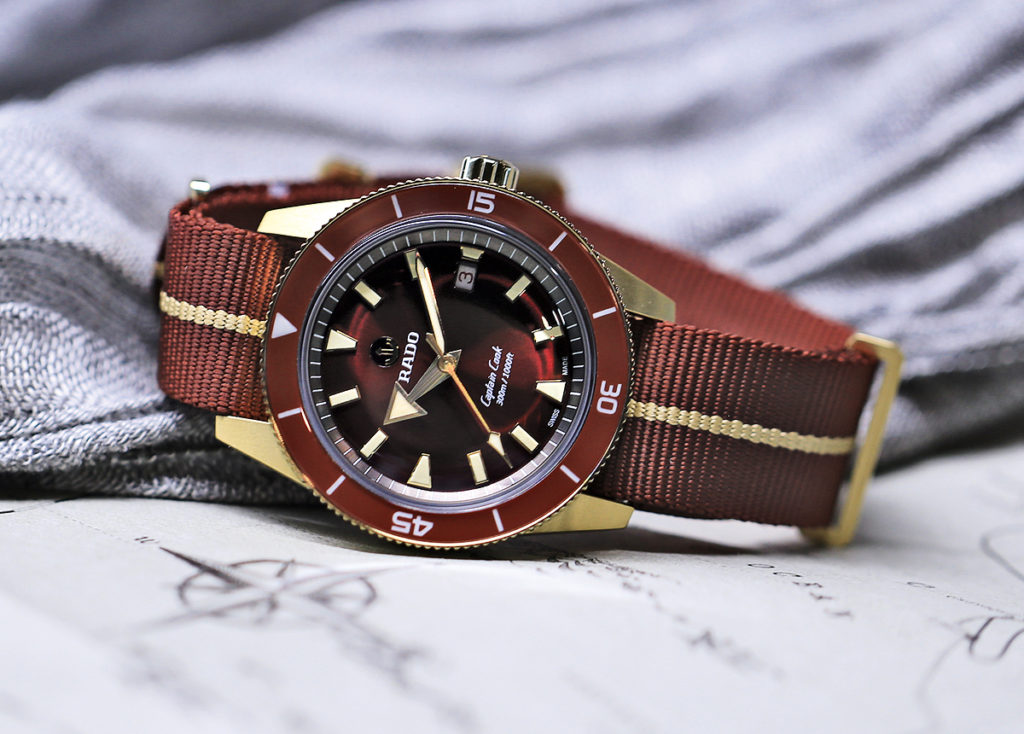
“It looks Christmassy.” That was the first reaction from my wife upon seeing the Rado Captain Cook Burgundy Bronze on my wrist, after I’d strapped it on for the first time last December. And while it’s doubtful that Rado’s designers had a yuletide aesthetic in mind when they envisioned this timepiece, there can be no doubt that its overall look is festive, and easily the most playful in the Captain Cook series since it made its modern debut in 2017.
Rado’s resurrection of the Captain Cook — originally a relatively obscure divers’ watch produced from about 1962 to 1968, and named after the 18th-century British explorer and navy captain James Cook — has proven to be one of the Swiss brand’s most savvy moves in recent years. Not only has the watch, with all of its distinctly retro elements, taken a place of honor in the burgeoning category of vintage-influenced dive watches; it has also given Rado a more classical style of timepiece with which to flaunt its “master of materials” cred, particularly in the use of high-tech ceramics and, more recently, bronze. Previous Captain Cook models have paired bronze cases with blue, brown and green dials; this latest model, which I had a chance to review shortly after its debut, is the first to match bronze with a deep red colorway that appears to be on the cusp of having a big moment in the watch world.
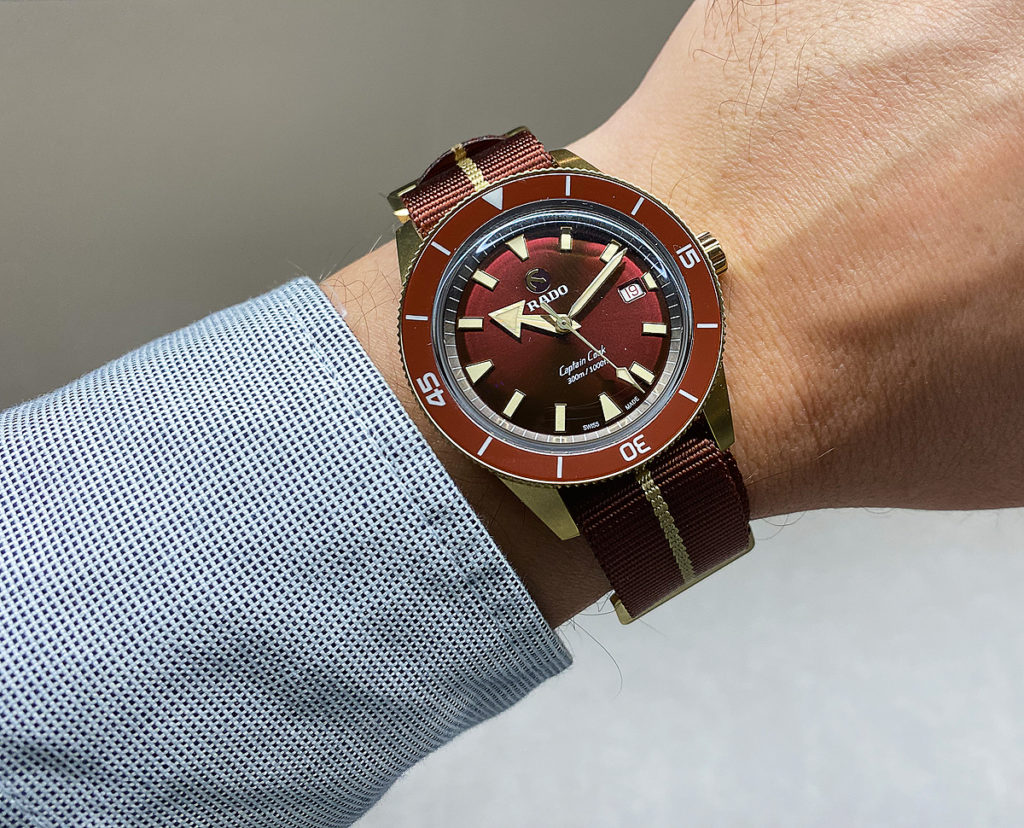
The Captain Cook’s brushed bronze case is a healthy 42 mm in diameter (48.6 mm at the widest extension of the lugs), not at all understated, which is perfect for a watch that is clearly designed to draw admiring attention. At 12.5 mm, the case is not prodigiously thick, enabling it to nestle comfortably under a shirt cuff while still maintaining a stately presence. Many aficionados who have seen and worn both the more period-appropriate 37-mm and the larger 45-mm versions of the Captain Cook will likely appreciate the stylish middle ground that this model offers. As fans of the growing ranks of bronze-cased watches, from Rado and dozens of other watchmakers, are likely already aware, the material is especially appropriate for divers’ watches, having been used historically in underwater equipment.
Aside from the vibrant, luxurious colors, the Captain Cook is still a divers’ watch, with a classical, unidirectional divers’ bezel. Its fluted coin-like edges frame an insert made of matte burgundy-colored ceramic that echoes and enhances the dial’s color. (Red tones, for those not well-versed in ceramics, are among the hardest colors to replicate in that material.) The insert is laser-engraved with the hallmark, inverted triangle at 12 o’clock, along with thin bar indexes and Arabic numerals at the 15-, 30-, and 45- minute markers.
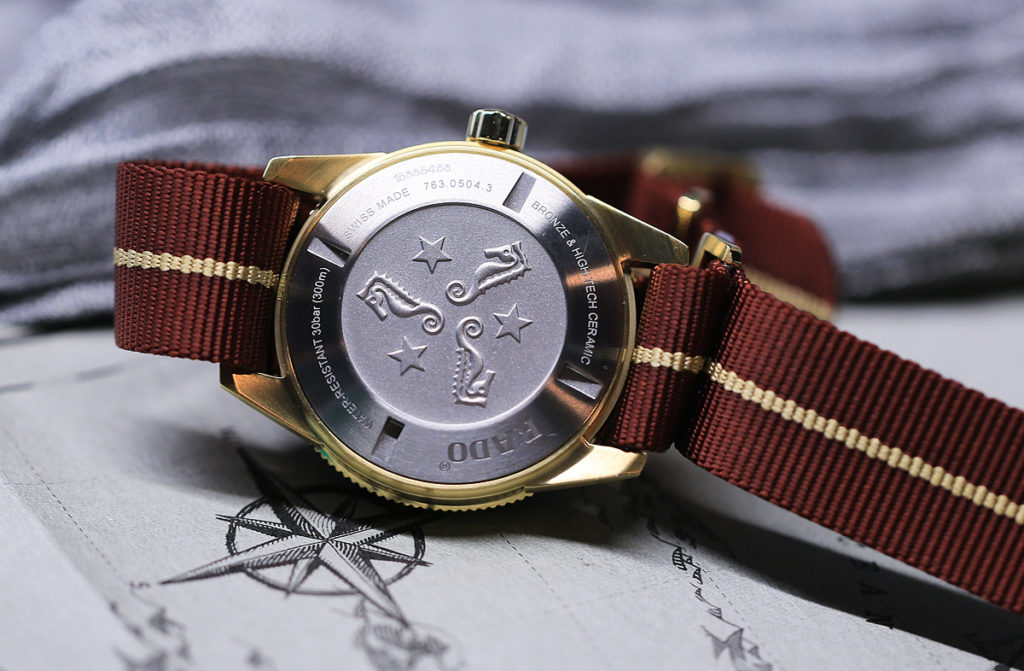
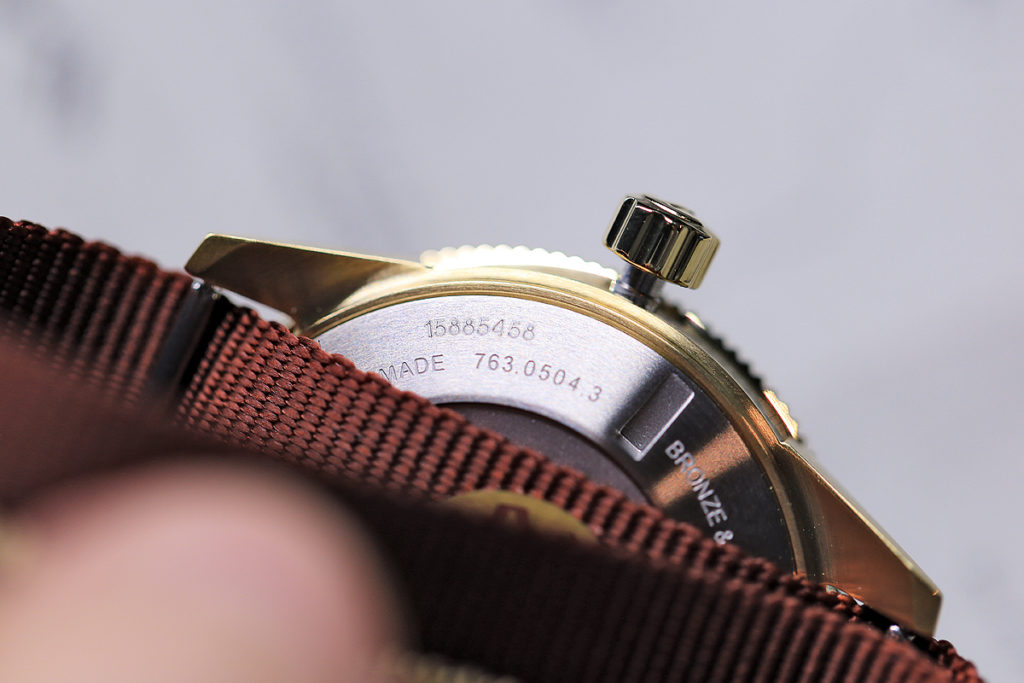
The fluted edge of the bezel is easy to grasp — even for wet divers’ fingers, I’d presume — and its audible ratcheting announces the watch’s presence proudly. Running your finger over the bezel and box-type crystal is a tactile pleasure: unlike many other such diving bezels, which tend to be flat or slightly domed to continue the curvature of the crystal, this one curves slightly inward, which helps accentuate the silhouette of the convex-domed sapphire crystal, which is treated with nonreflective coating on both sides. The screw-down crown has a polished finish and is large enough to grasp easily, yet small enough to be unobtrusive to the overall aesthetic, and to avoid rubbing against the wrist.
The burgundy dial under the crystal has a striking sunburst shine. Its contours are also notable, with the outer periphery of the dial curving downward and the rectangular indexes shaped accordingly. Wedge-shaped pentagons occupy the spots at 12, 6 and 9 o’clock, along with a shortened one at 3 o’clock that seems to be chopped down to size to accommodate the date window, with its telltale red numeral — a hallmark of the Captain Cook model carried over from its earliest incarnations. The indexes are framed in yellow gold, a complementary hue to the bronze areas of the case, and filled with Super-LumiNova for a brilliant nighttime glow. Hour and minute are quite easy to discern at a glance thanks to the wildly contrasting shapes of the main hands: the former is indicated by a short hand with a wide, prominent triangle pointer that barely brushes the inner edges of the hour markers, the latter with a thin, sword-shaped hand that sweeps over them. The central seconds hand has a thinner, curved triangle at its tip. Above the white-printed Rado logo is the Captain Cook family’s most unique feature, a small anchor symbol, here in yellow-gold coloring, on a synthetic ruby background, which subtly rotates with the motion of the wearer’s arm.
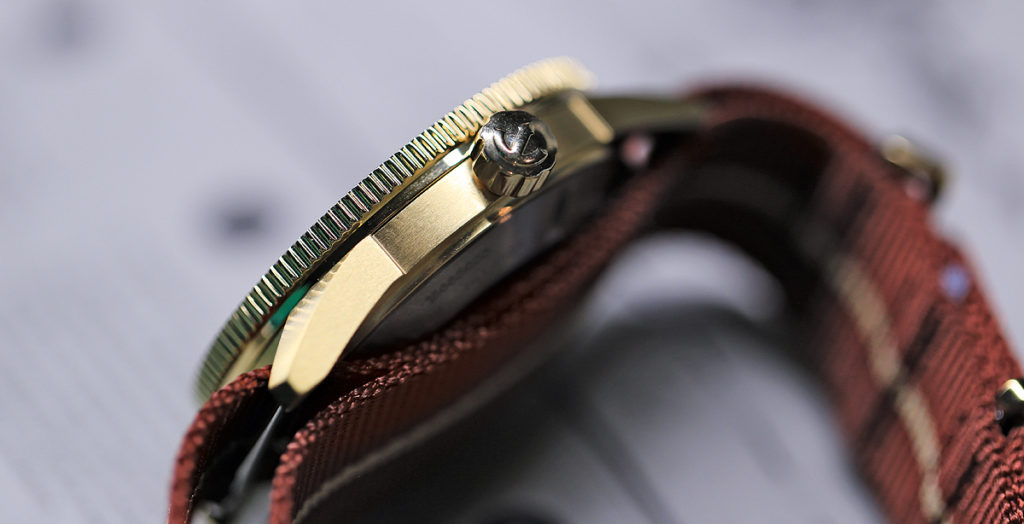
Another period detail recalling the 1960s Captain Cook models can be found on the solid caseback, namely three stamped seahorses that visually speak to the model’s maritime tool-watch heritage, its naval namesake, and its dive-ready 300-meter water resistance. Made of circular brushed titanium rather than bronze, which could discolor the wearer’s skin as it oxidized into an aged patina, this solid caseback covers the movement, Rado’s Caliber 763. The movement is based on the ETA C07.611, which is also the base movement for the Powermatic 80 family of calibers found in watches by many of Rado’s stablemates within the Swatch Group, including Hamilton, Mido and Tissot. The “Powermatic” designation, which Rado does not use in the official name of its version of the movement, refers to its automatic winding system and the lengthy 80-hour power reserve it offers when fully wound. To accommodate this extended running autonomy, movement-maker ETA toned down the base caliber’s balance frequency from 28,800 vph (4 Hz) to a more leisurely 21,600 vph (3 Hz).
The burgundy red color and the bronze-gold details continue on the sturdy yet soft NATO textile strap. Its buckle and loops are made of the same brushed bronze as the case, and it has a burgundy leather section stitched to one end to rein- force the holes for the buckle’s tongue, adding a subtle but appreciated layer of construction for an even more secure feel on the wrist. Like most bronze-cased watches, the appeal of the Captain Cook Bur-gundy Bronze can be summed up twofold: when it’s new, it has the luxurious look of gold, at a fraction of the price; as it ages and becomes exposed to air, water and other atmospheric factors, it develops a patina that makes it uniquely the wearer’s own. It’s not just for Christmastime, but it makes for a very personal gift, even if — as so often happens among watch lovers — the giver is also the recipient.
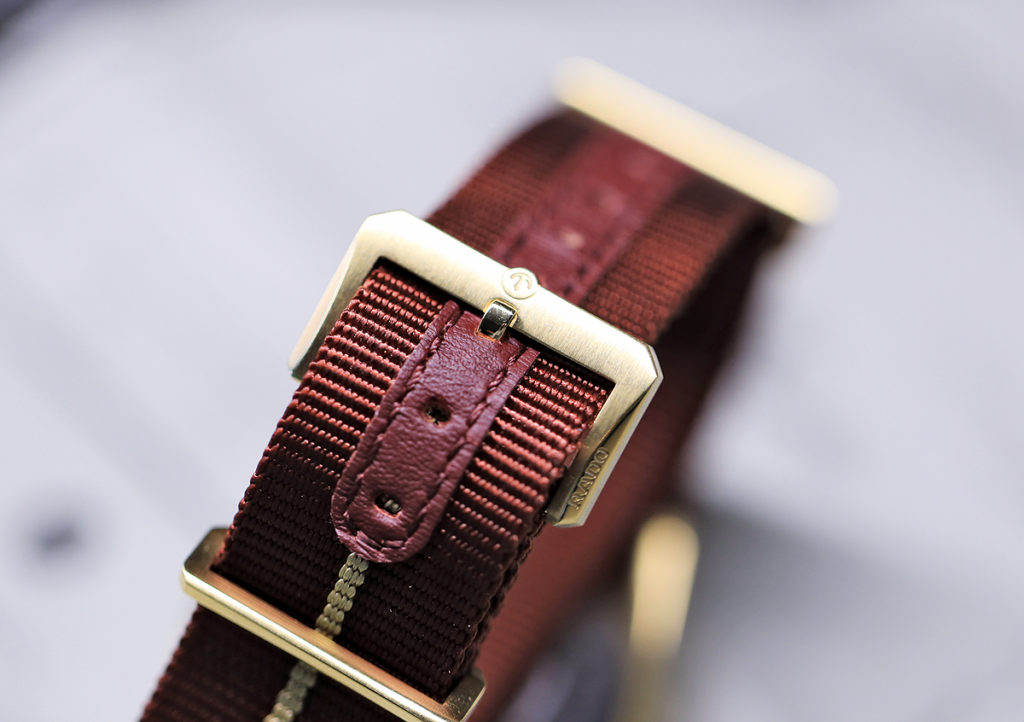
SPECS:
Manufacturer: Rado Watch Co. Ltd., Bielstrasse 45, 2543 Lengnau, Switzerland
Reference number: 763.0504.3.131
Functions: Hours, minutes, seconds, date
Movement: Rado Caliber 763, based on ETA C07.611, automatic, 25 jewels, 21,600 vph (3 Hz), 80-hour power reserve
Case: Brushed bronze case, bronze unidirectional rotating bezel with high-tech burgundy ceramic insert, circular brushed titanium caseback with three stamped seahorses, polished bronze screw-down crown, box-shaped sapphire crystal with nonreflective coating on both sides, water resistant to 300 meters
Dial: Sunray-finished burgundy dial, yellow-gold-colored hands and
applied indexes with Super-LumiNova inlays, yellow-gold-colored moving anchor symbol with synthetic ruby backplate
Strap and clasp: Burgundy textile NATO strap with gold-colored center line, brushed bronze pin buckle and loops
Dimensions: Diameter = 42 mm, height = 12.5 mm
Price: $2,600


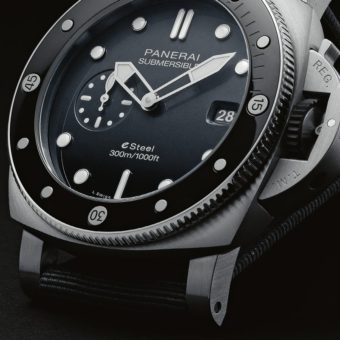
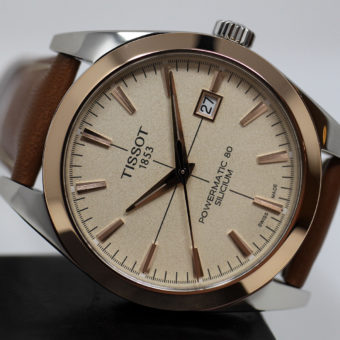
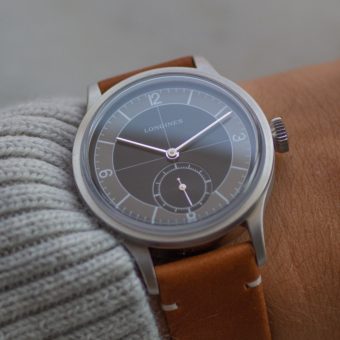
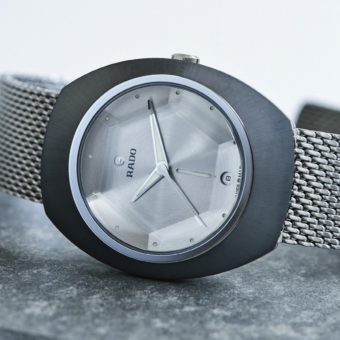
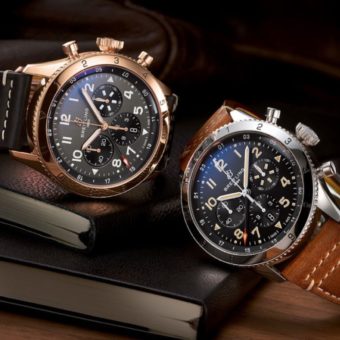
Don’t care for the hands, but the colors are fantastic!
I want one.
Rotating anchor is a feature, not unique to Captain Cook models only. Rado Hyperchrome 1616 has it as well.
Just when I was sure the new Omega Seamaster 300 coaxed is my first choice for my watch budget. I’m totally into the red Captain Cook. Wonderful description certainly adds to my interest. Thank you much appreciated